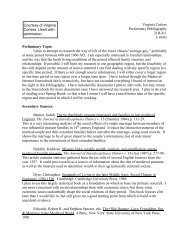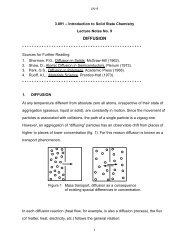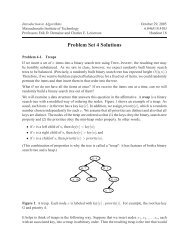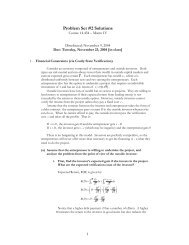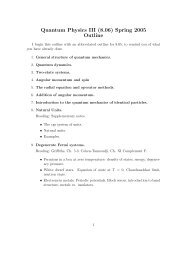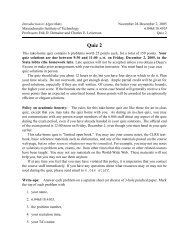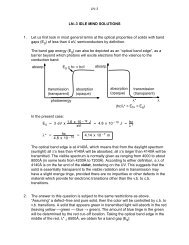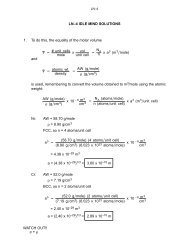18.03 Class 21, April 3 Fun with Fourier series [1] If f(t) is any decent ...
18.03 Class 21, April 3 Fun with Fourier series [1] If f(t) is any decent ...
18.03 Class 21, April 3 Fun with Fourier series [1] If f(t) is any decent ...
Create successful ePaper yourself
Turn your PDF publications into a flip-book with our unique Google optimized e-Paper software.
pi |---/ t = (pi/L)x| /|| / ||/ |-------------- x| Lso we have g(x) = f(t)= (4/pi) (sin(t) + (1/3) sin(3t) + ... ))= (4/pi) (sin(pi x / L) + (1/3) sin(3 pi x / L) + ...Then general appearance of the <strong>Fourier</strong> <strong>series</strong> for a function of period2L <strong>is</strong>g(x) = a0/2 + a1 cos(pi x / L) + a2 cos(2 pi x / L) + ...+ b2 sin(pi x / L) + b2 sin(2 pi x / L) + ...The integral formulas for an and bn can of course be translatedinto the variable x:an = (1/L) integral_{-L}^L g(x) cos(pi n x / L) dxbn = (1/L) integral_{-L}^L g(x) sin(pi n x / L) dx[5] Gibbs effect. What happens at points where f(t) <strong>is</strong>d<strong>is</strong>continuous?Definition: A function f(t) <strong>is</strong> "piecew<strong>is</strong>e continuous" if it <strong>is</strong>continuous except at some sequence of points $c_n$, and for each $n$both one-sided limits ex<strong>is</strong>t at $c_n$. (<strong>If</strong> the two limits are equal thenthe function <strong>is</strong> continuous there.)Notation: lim_{t-->c from above} f(x) = f(c+)lim_{t-->c from below} f(x) = f(c-)To find out, I got Matlab to sum the first 10 nonzero terms of the<strong>Fourier</strong> <strong>series</strong> for (pi/4) sq(t) ; that <strong>is</strong>,sin(t) + (1/3) sin(3t) + ... + (1/19) sin(19t)One thing's clear: the value of the <strong>Fourier</strong> <strong>series</strong> at 0 <strong>is</strong> 0 .Th<strong>is</strong> <strong>is</strong> a general fact:<strong>If</strong> f(t) <strong>is</strong>n't continuous at t = a , then the sum at t = aconverges to(f(a+) + f(a-))/2 .More surpr<strong>is</strong>ing <strong>is</strong> that the <strong>Fourier</strong> approximation has v<strong>is</strong>ibleoscillation about the constant values of sq(t),


![18.03 Class 21, April 3 Fun with Fourier series [1] If f(t) is any decent ...](https://img.yumpu.com/51148985/3/500x640/1803-class-21-april-3-fun-with-fourier-series-1-if-ft-is-any-decent-.jpg)

